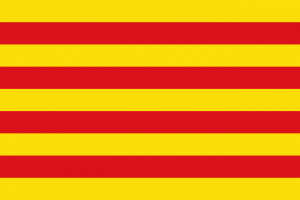Language/Catalan/Vocabulary/Numbers-1-100
Learning the numbers in Catalan is essential for basic communication, from discussing numbers of items, to prices, or even times. In this lesson, you will learn the numbers from 1 to 100 in Catalan, including how to pronounce them, write them, and use them in context. By the end of this lesson, you will have a solid foundation of Catalan numbers and be able to recognize and use them in common situations.
Numbers 1-20
The first step in learning Catalan numbers is to familiarize yourself with the numbers from 1 to 20. These numbers are the foundation for all larger numbers.
| Catalan | Pronunciation | English |
|---|---|---|
| zero | ['sew.βə] | zero |
| u | ['u] | one |
| dos | ['dɔs] | two |
| tres | ['tɾɛs] | three |
| quatre | [kwə'tɾe] | four |
| cinc | ['siŋk] | five |
| sis | ['sis] | six |
| set | [sɛt] | seven |
| vuit | [βwit] | eight |
| nou | ['nɔw] | nine |
| deu | ['dɛw] | ten |
| onze | ['on.zə] | eleven |
| dotze | ['dot.zə] | twelve |
| tretze | ['tɾɛt.zə] | thirteen |
| catorze | [kə.toɾz] | fourteen |
| quinze | ['kinzə] | fifteen |
| setze | ['set.zə] | sixteen |
| disset | [di'sɛt] | seventeen |
| divuit | [di'βwit] | eighteen |
| dinou | [di'nɔw] | nineteen |
| vint | [bint] | twenty |
- Catalan numbers from 1 to 20 are irregular and have unique forms.
- Note that "zero" is pronounced like in English but without the trailing "h".
- Catalan numbers consist of one word only, unlike in English where some numbers need to be hyphenated.
Numbers 21-100
After learning the numbers from 1 to 20, the next step is to learn the numbers from 21 to 100. Unlike the first 20 numbers, the rest of the numbers in Catalan are formed by combining the words for tens and ones using a hyphen (-).
The rule for forming these numbers is straightforward: take the multiple of ten (20, 30, 40, etc.), add the word for the corresponding unit (one, two, three, etc.) with a hyphen in between. For example, 23 would be "vint-i-tres" (twenty and three).
The word "i" (and) is used only between the tens and the ones, but not between the hundreds and tens. For example, 425 would be "quatre-cents vint-i-cinc" (four hundred twenty-five). Here are some examples:
| Catalan | Pronunciation | English |
|---|---|---|
| vint-i-u | ['bin.ti.'u] | twenty-one |
| trenta-cinc | [tɾen'ta.sin] | thirty-five |
| quaranta-nou | [kə.ɾan'ta.nɔw] | forty-nine |
| cinquanta | [siŋ'kan.ta] | fifty |
| seixanta-vuit | [səj'ʃan.ta.'βwit] | sixty-eight |
| setanta-tres | [sə'tan.ta.tɾɛs] | seventy-three |
| vuitanta-sis | [βwi'tan.ta.sis] | eighty-six |
| noranta-un | [no'ran.ta.u] | ninety-one |
| cent | [sɛnt] | one hundred |
- Note the "i" (and) used between the tens and the ones, but not between the hundreds and tens.
- Once the rule for forming the numbers is understood, the rest of the numbers from 21 to 100 are easy to deduce.
Using numbers in context
Now that you know the Catalan numbers from 1 to 100, it's time to practice using them in context. Here are a few common situations where numbers are used:
Quantities and Prices
- ¿Quants (pronounced ['kants])? - How many?
- Un cafè, sis croissants i dues coca-colas, siszeuros___. - One coffee, six croissants, and two coca-colas, sixteen euros.
- La pensió costa vuitanta-cinc euros per nit__. - The hotel costs eighty-five euros per night.
Telling Time
- Quina hora és (pronounced ['kinə 'ow.ɾə 'ɛs])? - What time is it?
- Són les cinc menys cinc (pronounced ['son ləs θiŋks 'mɛnys θiŋk]) - It is five to five.
- És la una passada (pronounced ['ɛs la 'unə pa'saðə) - It is one past.
Phone Numbers
- El meu número de telèfon és sis-set-vuit-cinc-cinc-nou. (pronounced [əl 'mew 'num.bɾə də tə'lɛ.fon ɛs sis sɛt βwit sinθɾə]). - My phone number is 678559.
Room numbers
- La meva habitació és el número quaranta-dos (pronounced [lə 'mewə aβi.ta'sjɔ es əl 'num.βɾə kə'ɾan.ta.dos]). - My room is number forty-two.
Conclusion
Congratulations on learning the numbers from 1 to 100 in Catalan! This is a significant milestone in your journey to become proficient in the language. Now you can go on to more advanced topics, such as telling time, using numbers to discuss money, and even higher numbers. Practice your skills with friends or by listening to Catalan media, and don't forget to have fun!

